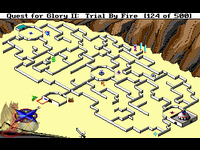|
|

|
BATTLE SYSTEM
|

|
INTERACTION
|

|
ORIGINALITY
|

|
STORY
|

|
MUSIC & SOUND
|

|
VISUALS
|

|
CHALLENGE
|
medium |
COMPLETION TIME
|
5 to 15 hours
|
|
OVERALL
4.0/5
|
Rating definitions
|
|
|
Being a Hero isn't always easy. It's not always about meeting shapely
moneychangers in the night. There's not always Katta performing
erotic fertility rites. There's isn't always a large harem of unrequited
nymphomaniacs.
But sometimes there is. Of course, there's a dark wizard. And monsters.
And corrupt government dignitaries. And rampaging elementals capable
of destroying entire cities unless you somehow stop them. Fortunately,
as a graduate of the Famous Adventurer's Correspondence School and
recently crowned Hero of Spielburg, you are on hand to handle the
good(s) and the bad in Quest for Glory II: Trial by Fire.
QFGII is a direct continuation of the previous Quest
for Glory game, in which you start as a lowly wandering Hero
with naught but a scrap of paper from a correspondence school but
end as the Hero of Speilburg. You travel to the land of Shapeir,
a desert country, on a magic carpet with friends that you met in
Speilburg.
Arriving in the capital, you quickly learn that Shapeir is also
troubled. Its sister city across the great desert, Rasier, has fallen
prey to evil: the Katta were cast out and few who go there return.
Forces sent by the Sultan were driven back by a suspicious sandstorm,
and now rumors of dark magics trouble Shapeir.
 RAWR!
RAWR! |
|
The plot of QFGII is much more linear and guided than the
previous installment. Time advances through a day/night cycle with
specific events happening on certain days. Some events, particularly
important game-advancing events, have a limited time frame and ultimately
the plot will progress regardless of player intention. But this
is not necessarily a detraction as ample time is provided to build
stats, discover clues, and generally explore the city and its surrounding
desert.
Players choose their hero from one of three classes: fighter, mage,
or thief. Additionally, veterans can import their saved character
from QFGI, most likely gaining a slight advantage in terms
of equipment and stats. Choice of class plays a direct role in the
game as many of the events, puzzles, and solutions are class specific:
to gain a needed quest item a fighter might arm-wrestle for it,
a mage might use magic to fetch it from afar, or a thief might sneakily
purloin it. Hybrid characters may also be created, combining aspects
of multiple classes. New to the series is the class of paladin,
a class that can only be earned - not chosen - at the end of the
game.
Class also affects the base stats and skills. Stats are a base
measurements which indirectly affect other pools, i.e. strength
affects both health and the amount of weight that can be carries.
Skills are a measure of ability in a given area, such as climbing
or weapon use. Sierra added a few new skills and stats for this
incarnation, including communication that allows one to bargain,
and the honor base stat. Honor is related to the paladin subquest
and is the only stat that cannot be directly increased.
Stats and skills are increased through usage and are immediately
applied. Casting a spell over and over might increase that spell's
individual level, the magic skill itself, or even the base stat
of intelligence or luck. In this manner, the game rewards skills
that are actively used. Of course, many of these skills can be spammed
to maximum, but some safeguards are built-in.
 Be grateful to your map.
Very grateful.
Be grateful to your map.
Very grateful. |
|
The combat engine is slightly more advanced in QFGII than
it was in its predecessor but still delightfully primitive. Instanced
encounters occur when the Hero is approached by an enemy. The Hero
can swing or thrust, using either sword (fighters only) or dagger,
parry with a sword, dodge, or cast combative magic. Health is drained
by wounds, and stamina is lost by any action; if either reaches
zero then the game ends.
The graphical palette is done in EGA style, and, despite the limitations
inherent, the game provides a finely detailed environment. Animations
are also well done, certainly quite comedic when appropriate. Music
is also nicely done with a variety of themes in suitable arrangements.
Overall, QFGII comes recommended, especially to veterans
of the previous game. While it is not necessary to have played QFGI
in order to enjoy QFGII, since the story is a continuing
arc spread over the series, it might be best to start at the beginning
if possible.
Review Archives
|









